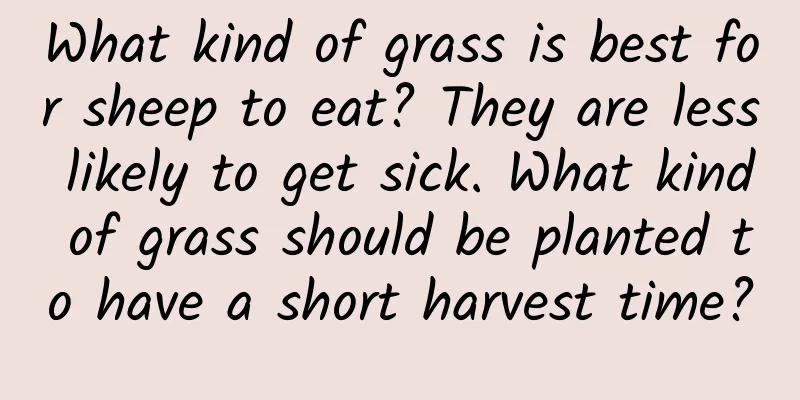What kind of grass is best for sheep to eat? They are less likely to get sick. What kind of grass should be planted to have a short harvest time?

|
As the saying goes: Sheep eat all kinds of grass, but then again, we can't plant all kinds of grass! Alfalfa from the Leguminosae family, sedge from the Asteraceae family, and annual ryegrass from the Gramineae family. These kinds of grass are ideal choices when combined with each other, and they are also what the animals like to eat, and they are not easy to get sick after eating them. AlfalfaAlfalfa is recognized as the " king of protein " among forage grasses. In addition, alfalfa contains high-quality dietary fiber and a variety of vitamins including vitamins B, C, and E. Moreover, it also contains a variety of beneficial minerals and bioactive ingredients such as saponins, carotenoids, and flavonoids, so it is the first choice for sheep farmers to grow forage grass . Spring and autumn are the best seasons for planting alfalfa , and autumn planting is better than spring planting. Because alfalfa seeds are small and have relatively weak ability to break through the soil, before sowing, it is necessary to cultivate the soil carefully and try not to leave any manure or soil in the soil. In addition, because alfalfa grows very slowly in the early stages and is easily "swallowed" by other weeds, it is best to remove weeds from the soil about half a month before land preparation. When planting alfalfa, you need to choose herbicides such as dimethoate and chloranil for spraying. If there are still many weeds after the seedlings, you can choose to use pursat, bentazon, and chloranil to eliminate the weeds. Alfalfa should be planted in rows , with a row spacing of 15 cm and a sowing depth of 1 to 2 cm. The sowing depth should be deep when the soil is dry and shallow when the soil is wet. It is best to press down after sowing to facilitate the emergence of seeds and prevent the seedlings from being hung due to loose soil after emergence. HerbThe nutrients of pine grass are high in crude protein and crude fiber, which are also the most needed substances for sheep. Therefore, pine grass is a large-leaf forage grass with good palatability for sheep. This grass also contains a high content of nitrogen-free extract, which is easier for sheep to absorb and utilize. Because of the high content of this substance, it is also more conducive to silage and is a higher quality silage feed. RyegrassRyegrass is divided into different varieties such as winter grazing 70 ryegrass, annual ryegrass, perennial ryegrass and multiflora ryegrass. It can grow well in late autumn, early winter and early spring, and can be used as a green supplementary feed during the dry grass period. Under proper planting and management, the yield of fresh grass per mu can reach about 20,000 catties, equivalent to about 6,000 catties of hay, and one mu of land can feed 8 sheep . For the ryegrass that cannot be eaten in the abundant grass season, it can be dried and stored. |
<<: Warm-season turf grasses What are the common varieties and types of warm-season turf grasses?
Recommend
What to do if the black orchid has root rot
Causes of root rot Overwatering The main reason f...
How to remedy the yellowing of the leaves of the fortune tree? Is there any way to save it if the roots rot and become soft due to overwatering?
1. What to do if the leaves turn yellow 1. Reason...
Can Gardenia cuttings survive?
1. Can cuttings survive? Gardenia cuttings can su...
What are the common varieties of Daphne koreana
Common varieties of Daphne koreana Depending on t...
What does the aerial root of Monstera look like (the role of the aerial root of Monstera, how to handle and protect it)
The role of Monstera aerial roots: Appearance : T...
Ecological functions of tree stranglers
As bird food Despite its nickname of "strang...
How long is the growth cycle of tea trees?
Introduction to Tea Tree Growth Tea trees origina...
What kind of environment is suitable for Christmas cactus to grow in (where does Christmas cactus like to grow)
What kind of growing environment does Christmas c...
How to care for forget-me-not
1. Suitable substrate Forget-me-nots have relativ...
How to plant dahlias? Planting time and method
Dahlia Planting Time It is best to plant dahlias ...
When is the best time to plant carrots?
The main edible part of a carrot is its fleshy ro...
How to grow a small potted fortune tree and the correct placement
1. How to raise 1. Water: The plant is not water-...
How to store passion fruit
Storage method Store at room temperature in a dry...
What fertilizer should be used to make the iron tree grow luxuriantly? The correct method of fertilization
It is best to fertilize the iron tree during its ...
Should I use a large or small pot for pine red plum?
Should I use a large or small pot for pine red pl...









